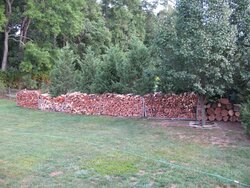What is the best resource for learning to identify downed wood - especially lacking leaves? We've been heating with a fireplace insert for about 6 years now and previously have taken advantage of our state forest downed wood cutting program - we were always directed to the downed tree and it was identified to us as to the type of tree. Price of the wood just doubled - still dirt cheap, but we've discovered a gold mine of free wood at our newly created Yard Waste landfill site only a couple of miles from home.
We've taken several things over there - grass clippings, etc. and have recycled in the true sense by bringing home wood others have dumped.
First time my son came home with a bunch of pine, not knowing what to look for. I've looked online a bit but not come up with a really good site that tells us how to identify wood by the bark. This past weekend we took over the debris from 8 hours of splitting wood and came home with almost of pickup load of wood. Luckily we ran into someone there who knew that the wood was probably Ash. Also grabbed some holly - that we knew as practically the entire tree had been dumped.
I'm thinking there used to be a paperback book out on trees - similar to one of those backyard birding books...
Anyone have any ideas or wisdom to share?
Thanks!
Karen
We've taken several things over there - grass clippings, etc. and have recycled in the true sense by bringing home wood others have dumped.
First time my son came home with a bunch of pine, not knowing what to look for. I've looked online a bit but not come up with a really good site that tells us how to identify wood by the bark. This past weekend we took over the debris from 8 hours of splitting wood and came home with almost of pickup load of wood. Luckily we ran into someone there who knew that the wood was probably Ash. Also grabbed some holly - that we knew as practically the entire tree had been dumped.
I'm thinking there used to be a paperback book out on trees - similar to one of those backyard birding books...
Anyone have any ideas or wisdom to share?
Thanks!
Karen



 . Some have been down a while too, and we've not noticed the piney smell or sap on what I suspected was pine. I want to refine that knowledge
. Some have been down a while too, and we've not noticed the piney smell or sap on what I suspected was pine. I want to refine that knowledge 